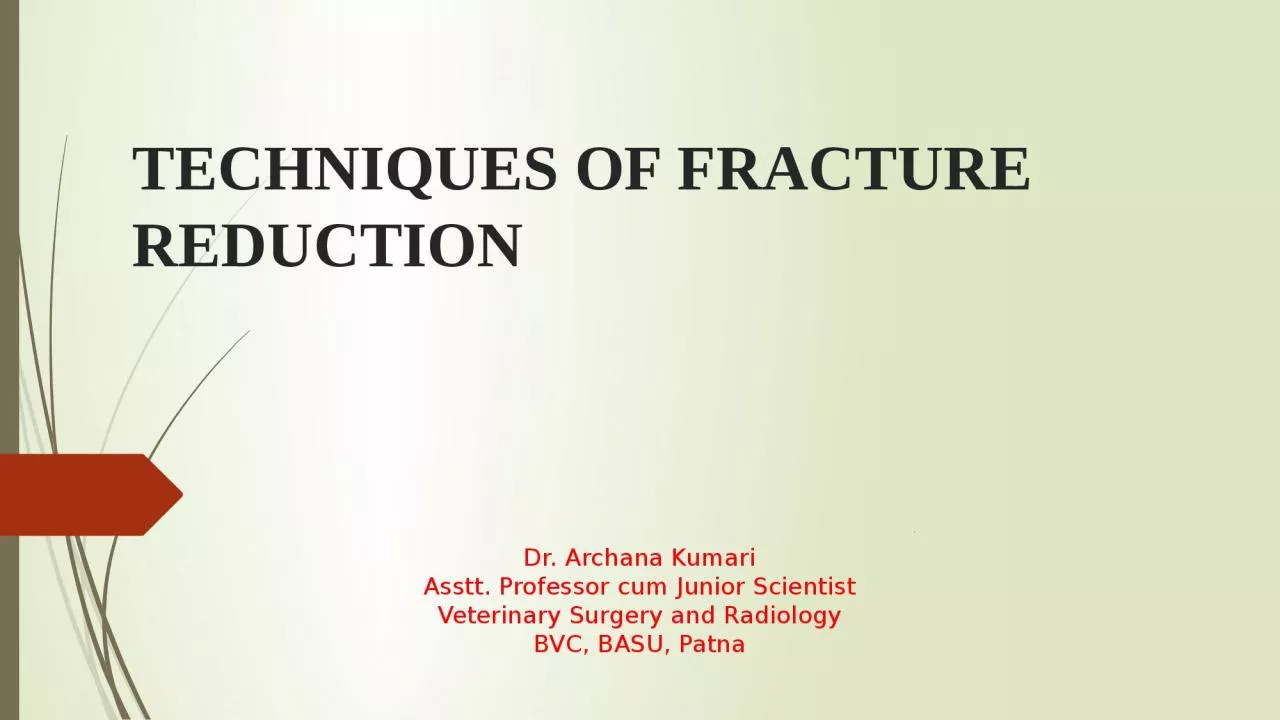

Dr Archana Kumari Asstt Professor cum Junior Scientist Veterinary Surgery and Radiology BVC BASU Patna PRINCIPALOF FRACTURE MANAGEMENT 4R Recognition Reduction Retention ID: 918251
Download Presentation The PPT/PDF document "Techniques of fracture reduction" is the property of its rightful owner. Permission is granted to download and print the materials on this web site for personal, non-commercial use only, and to display it on your personal computer provided you do not modify the materials and that you retain all copyright notices contained in the materials. By downloading content from our website, you accept the terms of this agreement.
Slide1
Techniques of fracture reduction
.
Dr. Archana
Kumari
Asstt
. Professor cum Junior Scientist
Veterinary Surgery and Radiology
BVC, BASU, Patna
Slide2PRINCIPALOF FRACTURE MANAGEMENT
4R
Recognition
Reduction
Retention
Rehabilitation
Slide3Methods of fracture reduction
Slide4.
The
reduction of fracture can be done either by
CLOSED REDUCTION
OPEN REDUCTION
Slide5CLOSED REDUCTION
Reduction of fracture without incising the skin or exposing the bone through
external
manipulation is called as
closed reduction
.
Normally after a closed reduction, fracture is immobilized with external fixation
techniques
, though sometimes intramedullary or external skeletal fixation is
done.
Slide6INDICATIONS
Fresh fractures in young animals, comprising only two pieces with little or no
overriding
of fragments
.
Closed
reduction
is generally done where bone segments can be easily palpable
with
less muscular coverage (radius and ulna).
Slide7ADVANTAGES Reduces
the risk of infection.
Trauma
to soft tissues from surgical exposure is avoided.
The
cost of initial treatment is less.
Slide8TECHNIQUE Under
sedation, the animal is secured in lateral recumbency
, by keeping the affected limb uppermost.
The test limb is held in lifted position for a few minutes, which helps in muscle relaxation and hence facilitate fracture reduction.
A rope or bandage is tied to the toe of the affected limb and straight traction is applied parallel to the long axis of the bone. This traction, counter traction and manipulation brings about reduction in some fresh cases with little overriding of fragments.
In case of oblique and overlapping segments toggling or angulation method is used
Slide9FRACTURE REDUCTION BY TOGGLING METHOD
Slide10DISADVANTAGES Decreased
ability to achieve anatomical realignment at the fracture site.
Prolonged
anaesthesia
if the first reduction is not perfect and the procedure must be repeated.
Development of fracture disease, if external fixation techniques
Slide11OPEN REDUCTION Open
reduction is achieved by exposing the fracture fragments
through an
incision
Open reduction is done primarily along with internal fixation, although at times external fixation is used.
Slide12INDICATIONS Fractures with severe comminution
Severe overriding of fracture fragments.
Slide13TECHNIQUE Under general
anaesthesia
, the fracture site is opened through a standard surgical approach.
Fracture fragments are exteriorized and reduction can be achieved, manually or with the help of bone clamps, by traction or toggling method.
Slide14.ADVANTAGES :
Fracture fragments can be directly visualized
Manipulation is easy
Soft tissue interposition between the segments can be avoided.
DISADVANTAGES :
Additional tissue trauma due to surgical incision.
Chances of getting infection is also more.